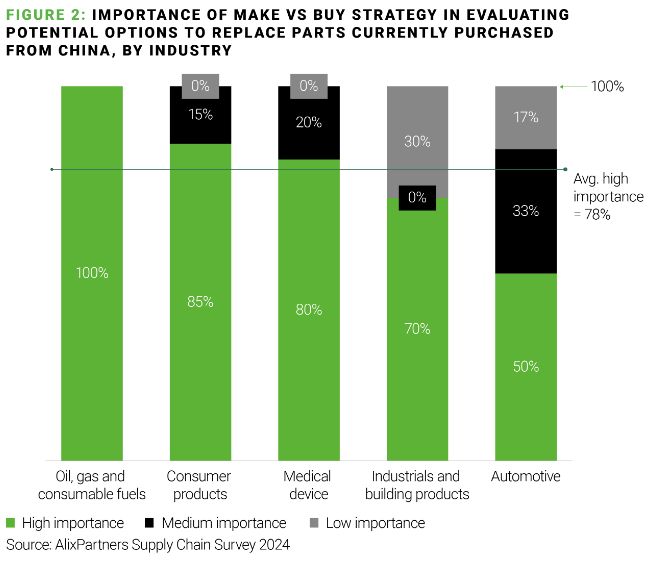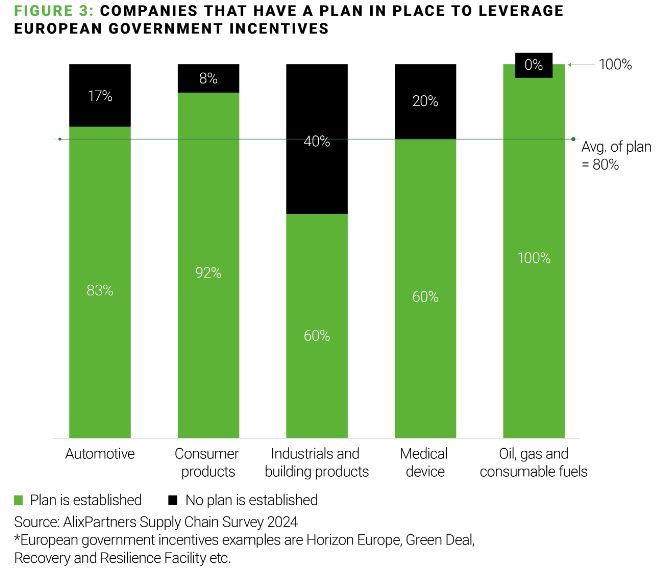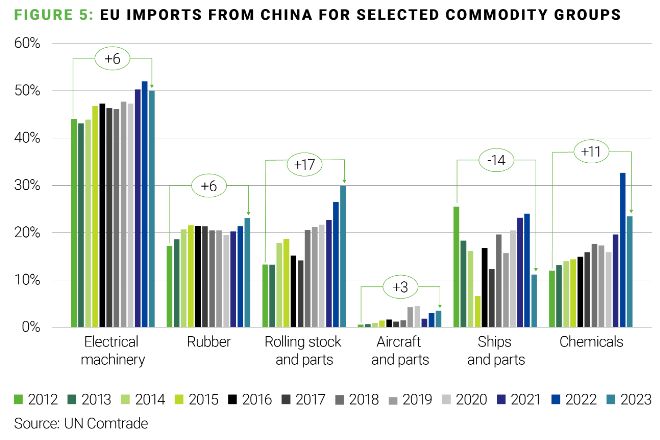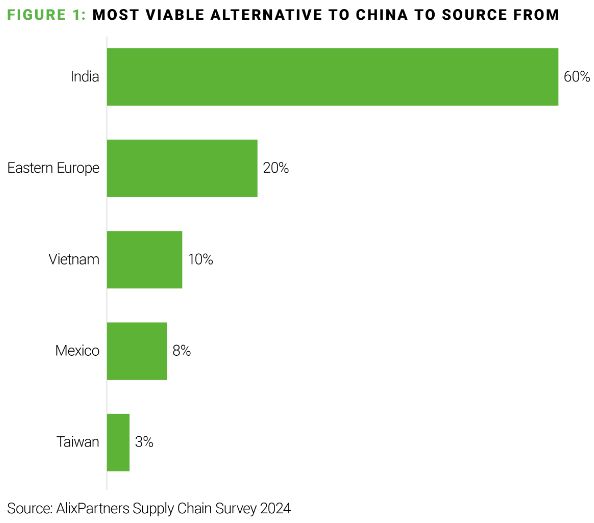In our EMEA supply chain survey, we discussed how
companies have reordered sourcing priorities, with efforts now
aimed at diversifying supply bases and employing near- or onshoring
strategies.
Here, we take a deep dive into the implications for the DACH
region (Germany, Austria, and Switzerland), revealing the reality
check required regarding decreasing dependence on China, plus
examples of government incentives in place across a number of
sectors.
Our key findings
- Decreasing dependence on China: A strategic
imperative, with 84% of respondents across EMEA viewing it as
crucial – and even stronger in the DACH region at 88%. - Plans and progress: Nearly all surveyed
companies are actively developing or implementing plans to decrease
China sourcing. - Challenges and solutions: Identifying
alternative suppliers and mastering global procurement cost
modelling are paramount for DACH companies. India is seen to be the
most viable alternative to China, followed by Eastern Europe,
Vietnam, Mexico, and Taiwan. - Government incentives: A pivotal factor in
facilitating the transition towards a “China+”
strategy. - Make vs Buy decisions: Critical for future
sourcing strategies, yet 20% of DACH respondents lack a concrete
plan.
Strategic implications for executives
- The importance of agility in supply chain strategy.
- Investing in global procurement capabilities.
- Leveraging government and local incentives.
Sourcing alternatives is key for DACH companies:
Comparable to other EMEA companies, Make vs Buy strategies and
government incentive programs remain important to DACH
businesses:


Decreasing dependence on China: A reality check
In the global movement towards de-risking supply chains, the
focus on minimizing dependence on China has been particularly
pronounced in the United States. However, the European Union, with
Germany at its core, reached a critical juncture in this endeavor
only recently, in 2022. This shift underlines a broader recognition
of the strategic necessity to diversify sourcing away from a
single-country dependency that has characterized much of the past
decades.
As illustrated above, India is seen as the primary alternative
for businesses looking to adjust their sourcing strategies in the
future, while countries like Vietnam, Mexico, and the Eastern
European region continue to gain traction as viable sources for
imports. Nonetheless, these alternatives start from a relatively
small base, indicating that the journey towards significant
diversification is still in its early stages.
Germany’s reliance on Chinese imports spans a vast array of
products. This includes not only consumer goods such as smartphones
and clothing but also, more critically, intermediate goods and raw
materials essential for various sectors of the German economy. The
dependency is starkly evident in the importation of certain
electronic and electrical components like batteries and
accumulators, along with specific raw materials such as rare earth
elements. China’s dominant production capacity and available
natural resources in these areas poses a considerable challenge for
German industries seeking alternatives.
Moreover, many of the critical raw materials imported from China
are indispensable for the production of future technologies,
including components vital for electric motors, wind turbines,
photovoltaic systems, and other green technologies crucial for
Germany’s transition towards a more sustainable economic
framework.
Despite the clear understanding within the business community of
the need to diversify supply chains and mitigate the dependency on
critical imports from China, the path forward is fraught with
complexity. The process of finding alternative sources is intricate
and anticipated to be prolonged, especially for goods where China
holds a leading global production role or where alternatives are
scarce. This situation underscores the necessity for a strategic
and methodical approach to reduce dependency on Chinese imports,
balancing immediate economic needs with long-term sustainability
and resilience objectives.


As reflected in the earlier table above, the importance
of government incentives cannot be understated, with two sectors in
particular drawing significant attention in this
respect:
Government incentives: Semiconductor sector
The German Government is actively deploying financial incentives
to entice semiconductor companies to establish production
facilities within the country. This strategic move, particularly in
the semiconductor industry, is bolstered by Germany’s desire to
become a pivotal node in the global semiconductor supply chain.
Given the sector’s minimal labor intensity, the disadvantage of
higher labor costs in Germany is offset by the availability of
highly skilled labor and the attractive incentives on offer.
Notable investments in this sector include:
- Intel in Magdeburg: A substantial investment
of €30 billion is earmarked for a new facility, with a
€10 billion subsidy proposed. The planned start of production
is in 2024, with the facility expected to be operational by
2029. - TSMC in Dresden: Traditionally focused on its
Taiwanese production, the Taiwan Semiconductor Manufacturing
Company (TSMC) is branching out to Dresden with a €5 billion
subsidy to mitigate risks associated with political tensions with
China. This diversification effort will see TSMC operating in
conjunction with Infineon, Bosch, and NXP, with production slated
to begin this year. - Infineon in Dresden: Infineon is set to expand
its existing plant with a €5 billion investment, seeking a
€1 billion subsidy. The expansion started production in 2023
and open by 2026. - Wolfspeed in Saarland: Planning a €3
billion investment for a new facility, Wolfspeed aims for a subsidy
of approximately €600 million, with production starting in
2025 and the opening scheduled for 2026.
All the aforementioned subsidies are pending approval from the
European Union. The projects are likely to be supported by the
Klimatransformationsfonds (“Climate Transformation
Fund”), the “EU Chips Act”, and/or IPCEI (Important
Projects of Common European Interest).
Government incentives: Steel sector
The steel industry in Germany is another beneficiary of
government subsidies, particularly aimed at addressing the
challenges of emissions reduction. The transition to emission-free
steel production is supported through significant financial
incentives:
- Thyssenkrupp in Duisburg: A €2 billion
subsidy has been granted for upgrading the plant to produce green
steel. This funding is part of a larger investment requirement,
with additional funding at risk due to legal challenges against the
Klimatransformationsfonds. The project, approved by the EU in July
2023, started production in 2023 and open in 2026. - ArcelorMittal in Bremen and
Eisenhüttenstadt: Targeting decarbonization projects,
ArcelorMittal is poised to receive €1.3 billion, with
operations expected to commence in 2026. The subsidy was approved
by the EU in February 2024. - Salzgitter Flachstahl: Secured a €1
billion subsidy for its decarbonization efforts, with the subsidy
approved by the EU in April 2023. The project began production in
2023 and become operational by 2026. - Funding for these initiatives may also come through “IPCEI
Wasserstoff” (Important Projects of Common European Interest
– Hydrogen), underscoring the strategic emphasis to transform
the steel industry into a greener and more sustainable sector.
These concerted efforts in both the semiconductor and steel
sectors highlight Germany’s strategic positioning and
commitment to not only diversify its supply chains but also to
embrace and lead in the transition towards a more sustainable and
technologically advanced industrial landscape.
Government incentives – Battery technology
Europe’s ambition to bolster its technological sovereignty
is vividly illustrated by its recent initiatives to localize
battery technology and manufacturing. With an eye on
electrification and sustainable energy solutions, significant
investments, strategic acquisitions, and targeted policy incentives
are paving the way for a resilient battery manufacturing ecosystem
across the continent.
The landscape for lithium-ion battery (LIB) manufacturing in
Europe is evolving, driven by the need for local value creation and
European sovereignty over LIBs. Initiatives like the
European Battery Alliance, and research programs
“Horizon 2020” and “Battery
2030+”, exemplify the concerted efforts to anchor
manufacturing within Europe:
- CATL
- Group14 Technologies’ acquisition
of Schmid Silicon Technology Holding GmbH, which marked a
significant leap towards bolstering the global battery supply chain
with advanced silicon battery technology. This strategic move,
enhancing Schmid Silicon’s silane factory in Spreetal, Germany,
aligns with the EU’s decarbonization goals and emphasizes
Europe’s dedication to advancing high-energy density battery
materials. - Tesla in Berlin
- Northvolt in northern Germany
These are supported by significant investments aimed at
fostering LIB ventures and constructing mega-factories, despite the
challenges and competition from dominant Asian manufacturers. In
addition, the competitive landscape faces threats from attractive
investment conditions in the US. This situation points to the need
for EU-wide support and streamlined approvals to bolster
continental battery production. Through strategic acquisitions and
policy incentives, Europe is actively shaping its energy transition
narrative, emphasizing local manufacturing, sustainability, and
innovation.
Recommendations
The path forward: Building resilient, cost-efficient, and
diversified supply chains.
- Strategic imperative of diversification: With
an overwhelming majority recognizing the need to reduce dependency
on China, diversification is no longer optional but a strategic
necessity for resilience and competitive advantage. - Challenges Ahead: The transition entails
significant challenges, notably finding capable alternative
suppliers and understanding the cost implications of
diversification. However, these are surmountable with the right
strategies and investments, particularly in global procurement cost
modelling. - Leveraging incentives: Executives must
navigate and leverage government and local incentives effectively
to facilitate the transition, with a notable disparity in readiness
between EU and US incentives. - Strategic decision-making: The Make vs Buy
decision is crucial in this transition, requiring a strategic
approach to evaluate and implement sourcing options that align with
corporate goals and market dynamics. - Future-proofing through agility: Building a
supply chain that is not only resilient but also agile and
cost-efficient is paramount. This includes exploring nearshoring
opportunities and investing in capabilities that enhance supply
chain visibility and flexibility.
This approach offers a comprehensive view for executives,
emphasizing the need for strategic planning, agility, and
leveraging incentives to navigate the shift away from
China-dependent supply chains, towards a more diversified and
resilient model.
The content of this article is intended to provide a general
guide to the subject matter. Specialist advice should be sought
about your specific circumstances.

